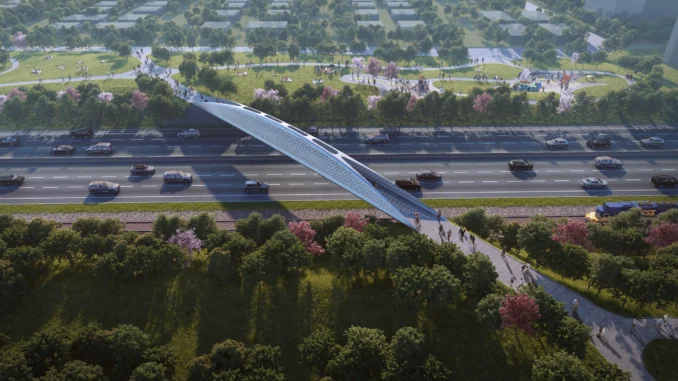
Owner of the Buffalo Bills Ralph C. Wilson Jr. left the park systems in Buffalo and his hometown of Detroit with a bequest exceeding $100 million upon his death in 2014.
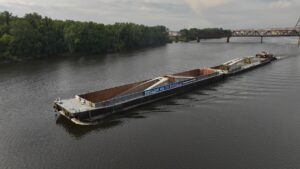
A large portion of that ground-breaking donation will go toward the 100-acre LaSalle Park, which spans Lake Erie, in Buffalo and is currently being redesigned by Michael Van Valkenburgh Associates under the name Ralph Wilson Park.
As part of the project, the current seawall will be replaced with a softer, more robust shoreline that offers more wildlife habitats. Approximately 2,000 trees will also be planted, and new bike and walking routes will be installed.
The addition of a new pedestrian bridge that will cross Interstate 190 and a freight rail line to improve connectivity between city dwellers and the revitalized lakefront, designed by the structural engineering and consulting firm Schlaich Bergermann Partner (sbp) in New York, is likely to be the most noticeable feature.
The steel bridge was recently completed after a lengthy journey by boat and barge through the Adriatic and Mediterranean Seas, over the Atlantic Ocean, up the Hudson River (with a stop at the Port of Coeymans south of Albany), and across the Erie Canal to Buffalo.
Fabricator and builder Cimolai, who joined frequent collaborator sbp as part of the project bid, constructed the bridge in San Giorgio di Nogaro, Italy.The bridge’s installation is scheduled for this fall.
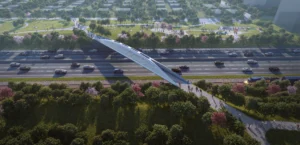
The new structure replaces a poorly lit switchback bridge, which was not known for its safety. The design by sbp will address those security concerns through several measures.
By placing the bridge at an angle over the interstate and freight rail below, the team was able to extend its length to 266 feet, or about double the length of the prior bridge, to allow for the substantial ramps rather than switchbacks, on either side of the structure.
The new bridge is also substantially broader, with some 16 feet of clear walking space; and, lastly, a luminous LED display will keep the bridge well-lit during evening hours.
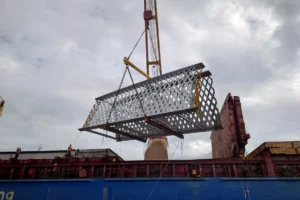
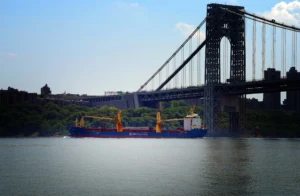
While the configuration of the new bridge will allow for direct vistas towards Lake Erie, the design team still had to contend with the unsightly—and often loud—interstate below.
To that end, according to sbp partner Stephan Hollinger, the bridge incorporates perforated hangar plates, rather than typical cables, to better shield users from the noise.
The design also provides an opportunity to create a new city landmark. “We are trying to create not just something unique, but a structure that relates to Buffalo’s industrial and architectural heritage,” explains Hollinger.
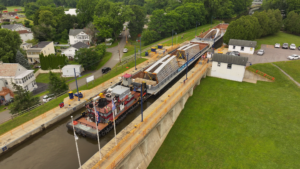
In the opinion of some, the Erie Canal made New York. The canal opened in 1825, winding its way through the Mohawk Valley, between the dense peaks of the Catskill and Adirondak Mountain ranges, to link the Hudson River with the Great Lakes.
Buffalo, at the canal’s western extremity, emerged as one of leading grain ports in the country, acting as a crucial go-between for the agricultural heartland of the continental United States and international markets.
While the city’s heyday as a leading entrepot is long gone, and the Erie Canal has largely faded into a touristic relic, replete with vacation barges, it just so happens that the canal proved the most expeditious route for transporting the bridge, which was fabricated and shipped in four sections.
The two-week journey across the waterway, which celebrates its bicentennial next year, brought thousands to its banks.
“People were both awed by the bridge’s beauty and the engineering marvel that is the Erie Canal, that can still ship cargo like this,” says Ralph Wilson Park Conservancy executive director Katie Campos. “It is part of a very positive movement building in Buffalo, a city known for its architectural significance, that is now seeing reinvestment in its art and architecture.”
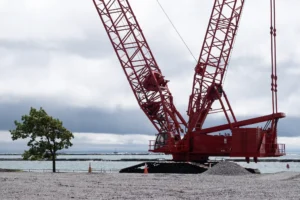
The bridge arrived along the shores of Ralph Wilson Park on July 15, and the process of welding and painting the components into a single tied-arch structure began shortly thereafter.
In September, it will be moved across the park to be prepped further, before being craned and installed into position in October. The revamped lakefront park is expected to open in phases starting in 2026.
Read more news on
sportchannel.co.uk
Leave a Reply